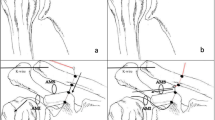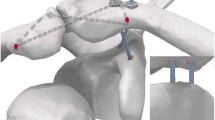Abstract
Purpose
The aim of this study was to evaluate the outcome of a minimally invasive surgical technique for the treatment of patients with acromioclavicular joint dislocation.
Methods
Sixteen patients with complete acromioclavicular joint dislocation were enrolled in this study. All patients were asked to follow the less active rehabilitation protocol post-operatively. Computed tomography with 3-D reconstruction of the injured shoulder was performed on each patient post operatively for the assessment of the accuracy of the suture anchor placement in the coracoid process and the reduction of the acromioclavicular joint. Radiographs of Zanca view and axillary view of both shoulders were taken for evaluating the maintenance of the acromioclavicular joint reduction at each follow-up visit. The Constant shoulder score was used for function assessment at the final follow-up.
Results
Twenty seven of the 32 anchors implanted in the coracoid process met the criteria of good position. One patient developed complete loss of reduction and another had partial loss of reduction in the anteroposterior plane. For the other 14 patients, the mean Constant score was 90 (range, 82–95). For the patients with partial and complete loss of reduction, the Constant score were 92 and 76 respectively. All of them got nearly normal range of motion of the shoulders and restored to pre-operative life and works.
Conclusion
With this minimally invasive approach and limited exposure of the coracoid, a surgeon can place the suture anchors at the anatomical insertions of the coracoclavicular ligament and allow the dislocated joint reduced and maintained well.
Level of evidence
Level IV, Case series; therapeutic study.










Similar content being viewed by others
References
Shin S-J, Yun Y-H, Yoo JD (2009) Coracoclavicular ligament reconstruction for acromioclavicular dislocation using 2 suture anchors and coracoacromial ligament transfer. Am J Sports Med 37(2):346–351
Yoo J-C, Ahn J-H, Yoon J-R et al (2010) Clinical results of single-tunnel coracoclavicular ligament reconstruction using autogenous semitendinosus tendon. Am J Sports Med 38(5):950–957
Debski RE, Parsons IM, Woo SL, Fu FH (2001) Effect of capsular injury on acromioclavicular joint mechanics. J Bone Joint Surg Am 83:1344–1351
Fukuda K, Craig EV, An KN, Cofield RH, Chao EY (1986) Biomechanical study of the ligamentous system of the acromioclavicular joint. J Bone Joint Surg Am 68:434–440
Morrison DS, Lemos MJ (1995) Acromioclavicular separation: reconstruction using synthetic loop augmentation. Am J Sports Med 23:105–110
Breslow MJ, Jazrawi LM, Bernstein AD, Kummer FJ, Rokito AS (2002) Treatment of acromioclavicular joint separation: suture or suture anchors? J Shoulder Elbow Surg 11:225–229
Chernchujit B, Tischer T, Imhoff AB (2006) Arthroscopic reconstruction of the acromioclavicular joint disruption: surgical technique and preliminary results. Arch Orthop Trauma Surg 126:575–581
Su EP, Vargas JH III, Boynton MD (2004) Using suture anchors for coracoclavicular fixation in treatment of complete acromioclavicular separation. Am J Orthop 33:256–257
Collins DN (2009) Disorders of the acromioclavicular joint. In: Rockwood CA, Matsen FA, Wirth MA, Lippitt SB (eds) The shoulder, 4th edn. Saunders, Philadelphia, pp 453–526
Jiang C, Wang M, Rong G (2007) Proximally based conjoined tendon transfer for coracoclavicular reconstruction in the treatment of acromioclavicular dislocation. J Bone Joint Surg Am 89:2408–2412
Korsten K, Gunning AC, Leenen LPH (2014) Operative or conservative treatment in patients with Rockwood type III acromioclavicular dislocation: a systematic review and update of current literature. Int Orthop 38(4):831–838
Guo HB, Xiao T (2014) Comment on Korsten et al: Operative or conservative treatment in patients with Rockwood type III acromioclavicular dislocation: a systematic review and update of current literature. Int Orthop 38(4):915
Modi CS, Beazley J, Zywiel MG et al (2013) Controversies relating to the management of acromioclavicular joint dislocations. Bone Joint J 95-B(12):1595–1602
Shih CM, Huang KC, Pan CC, Lee CH, Su KC (2015) Biomechanical analysis of acromioclavicular joint dislocation treated with clavicle hook plates in different lengths. Int Orthop 39(11):2239–2244
Walz L, Salzmann GM, Fabbro T, Eichhorn S, Imhoff AB (2008) The anatomic reconstruction of acromioclavicular joint dislocations using 2 TightRope devices: a biomechanical study. Am J Sports Med 36:2398–2406
Knut B, Elifho O, Chowaniec David M et al (2011) Biomechanical comparison of arthroscopic repairs for acromioclavicular joint instability: suture button systems without biological augmentation. Am J Sports Med 39(10):2218–2225
Jerosch J, Filler T, Peuker E, Greig M, Siewering U (1999) Which stabilization technique corrects anatomy best in patients with AC-separation ? An experimental study. Knee Surg Sports Traumatol Arthrosc 7:365–372
Wellmann M, Zantop T, Weimann A, Raschke MJ, Petersen W (2007) Biomechanical evaluation of minimally invasive repairs for complete acromioclavicularjoint dislocation. Am J Sports Med 35(6):955–961
Costic RS, Vangura A Jr, Fenwick JA, Rodosky MW, Debski RE (2003) Viscoelastic behavior and structural properties of the coracoclavicular ligaments. Scand J Med Sci Sports 13:305–310
Nu¨ chtern JV, Sellenschloh K, Bishop N (2013) Biomechanical evaluation of 3 stabilization methods on acromioclavicular joint dislocations. Am J Sports Med 41(6):1387–1394
Wook CS, Joo LT, Ho MK et al (2008) Minimally invasive coracoclavicular stabilization with suture anchors for acute acromioclavicular dislocation. Am J Sports Med 36(5):961–965
Friedman DJ, Alton BO, Catalano L (2008) Coracoclavicular stabilization using a suture anchor technique. Am J Orthop (Belle Mead NJ) 37(6):294–300
Costantini A (2008) Acromioclavicular joint and scapular ligaments. In: Di Giacomo G, Pouliart N, Costantini A, De Vita A (eds) Atlas of functional shoulder anatomy, 1st edn. Springer, Milan, pp 27–59
Harris RI, Vu DH, Sonnabend DH et al (2001) Anatomic variance of the coracoclavicular ligaments. J Shoulder Elbow Surg 10(6):585–588
Yehia B, El-Ganainy Abd-El-Rahman A, Mazen A-S (2010) Acromioclavicular joint reconstruction using anchor sutures: surgical technique and preliminary results. Acta Orthop Belg 76(3):307–311
Scheibel M, Dröschel S, Gerhardt C et al (2011) Arthroscopically assisted stabilization of acute high-grade acromioclavicular joint separations. Am J Sports Med 39(7):1507–1516
Rios CG, Arciero RA, Mazzocca AD (2007) Anatomy of the clavicle and coracoid process for reconstruction of the coracoclavicular ligaments. Am J Sports Med 35:811–817
La ¨dermann A, Gueorguiev B, Stimec B, Fasel J, Rothstock S, Hoffmeyer P (2013) Acromioclavicular joint reconstruction: a comparative biomechanical study of three techniques. J Shoulder Elbow Surg 22(2):171–178
Beris A, Lykissas M, Kostas-Agnantis I et al (2013) Management of acute acromioclavicular joint dislocation with a double-button fixation system. Injury 44(3):288–292
Author information
Authors and Affiliations
Corresponding author
Ethics declarations
Funding
There was no external source of funding for this investigation.
Conflict of interest
The authors declare that they have no conflict of interest.
Ethical approval
All procedures performed in studies involving human participants were in accordance with the ethical standards of the institutional research committee and with the 1964 Helsinki declaration and its later amendments or comparable ethical standards.
Rights and permissions
About this article
Cite this article
Xiong, C., Lu, Y., Wang, Q. et al. Anatomical principles for minimally invasive reconstruction of the acromioclavicular joint with anchors. International Orthopaedics (SICOT) 40, 2317–2324 (2016). https://doi.org/10.1007/s00264-016-3283-3
Received:
Accepted:
Published:
Issue Date:
DOI: https://doi.org/10.1007/s00264-016-3283-3




